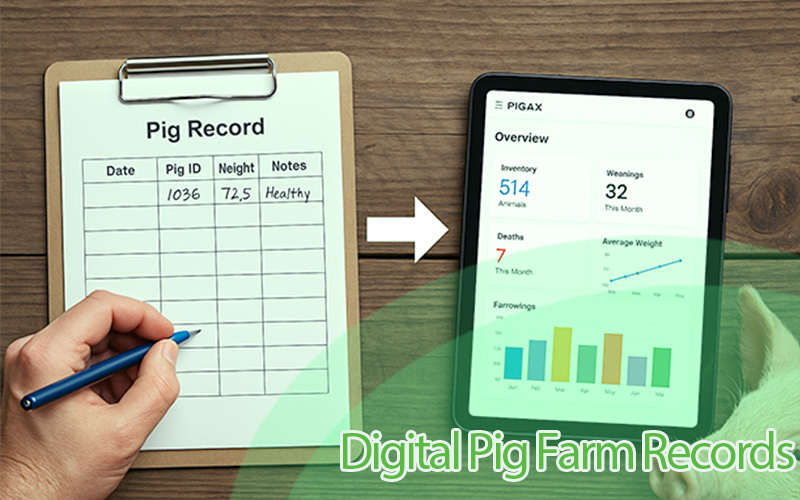Feed inventory techniques for efficient pig farming
Making sure your pigs get the right food at the right time is the most important function of a pig farm. How well you manage this function can make a big difference in how healthy and happy your pigs are, and in turn, how well your farm does. This is where feed inventory comes into play
What is pig feed Inventory?
Feed inventory refers to the total stock or quantity of various feeds, including grains, supplements, and specialized feeds, currently available on a farm or within a farming operation at a given time.
This inventory encompasses the different types and batches of feed, serving as a comprehensive record of the farm's feed resources. Proper management of feed inventory is essential for ensuring a consistent and well-balanced diet for pigs. It plays a critical role in supporting their health, growth, and overall well-being. Diligent farmers must adopt the best practices for efficient feeding techniques.
Now, let's dive into five straightforward techniques that can help you manage your pig feed inventory successfully.
Feed Inventory Techniques
There are various methods for keeping track of feed consumption on the farm and ensuring the steady availability of feed. Let us go through 5 various techniques.
1. Regular Audits:
Regular audits involve systematic and routine checks of the available feed inventory on the farm. These audits serve as a crucial practice to maintain accuracy in tracking the quantity of feed at any given time. By conducting regular audits, farmers gain insights into the current levels of feed, allowing for precise planning and preventing situations where there might be insufficient feed for the pigs. It's essentially a way of double-checking the pantry to make sure you never run out of essential supplies.
2. Automated Systems:
The implementation of automated inventory management systems brings technology into play for real-time tracking of feed usage. These systems use technology to streamline the tracking process, reducing the likelihood of human errors associated with manual record-keeping. Automated systems provide instant and accurate data about the feed inventory, enabling farmers to make informed decisions promptly. It's like having a digital assistant that keeps an eye on your feed levels and updates you in real time.
3. Batch Tracking:
Batch tracking involves assigning specific batches of feed to different groups of pigs based on their unique requirements. This technique allows farmers to monitor and manage feed consumption patterns for distinct pig groups. By tailoring feed allocation, farmers can optimize nutritional efficiency and cost-effectiveness. It's similar to sorting different types of candies for different groups of friends – each gets what suits them best, ensuring both variety and specificity in the pigs' diet.
4. Forecasting and Planning:
Forecasting and planning entail using historical data and growth projections to estimate future feed requirements. By analyzing past trends and anticipating the nutritional needs of the pigs as they grow, farmers can proactively plan their feed orders. This technique ensures that there is a sufficient supply of feed to meet the evolving needs of the pig herd. It's akin to looking at the weather forecast to decide whether to carry an umbrella – anticipating and preparing for what lies ahead.
5. Supplier Collaboration:
Effective communication with feed suppliers is a key aspect of feed inventory management. Establishing strong collaboration ensures reliable and timely deliveries of feed. By keeping an open line of communication, farmers can prevent disruptions in the supply chain, ensuring a consistent and quality source of feed for the pig herd. It's analogous to having a good relationship with your favorite pizza delivery place – clear communication ensures you always get your pizza when you need it.
It's like talking to the people who bring you your favorite pizza. If you talk to them and make plans, you'll always have pizza when you want it. The same goes for pig food. Keep in touch with the people who give you pig food, so you always have a fresh supply for your hungry pigs.
Pig Feed Inventory with Pigax
When it comes to feed inventory, Pigax Pig management software plays a pivotal role in assisting farmers with inventory tasks related to pig feed management. The software offers a user-friendly interface that allows farmers to conduct regular audits efficiently, providing real-time insights into the current levels of feed on the farm. With automated systems integrated into Pigax, the software minimizes the risk of human errors in tracking feed usage, ensuring precise and accurate data about the feed inventory. This is one factor to look at when choosing a pig management software.
Pigax facilitates batch tracking by enabling farmers to categorize and allocate specific batches of feed to different pig groups, streamlining the process of monitoring consumption patterns and optimizing feed allocation based on the unique needs of each group.
The software incorporates forecasting and planning features, utilizing historical data and growth projections to estimate future feed requirements. This proactive approach enables farmers to plan feed orders in advance, mitigating the risk of shortages.
Additionally, Pigax enhances supplier collaboration by providing a centralized platform for communication with feed suppliers, streamlining the ordering process, and reducing the likelihood of disruptions in the feed supply chain. Overall, Pigax serves as a comprehensive solution, leveraging technology to simplify and enhance the efficiency of pig feed inventory management tasks for farmers.
Use Pigax inventory to improve the efficiency of feeding in your pig farm and keep your pigs happy. Remember, when your pigs are happy, your farm is happy too!




